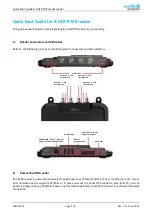
21
APPLICATION OVERVIEW
Control and monitoring systems can play an essential role in heat
tracing applications which range from freeze protecting water lines
to maintaining elevated process temperatures. While mechanical
thermostats have been used successfully for many heat tracing
applications, a more complete control and monitoring solution can
be necessary for critical heat tracing applications. Advancements
in technology have made electronic control and monitoring units
both cost effective and more reliable. These systems conserve
energy, extend system life, and ensure accurate temperatures
are maintained, for reduced operating cost and increased plant
reliability.
TraceNet Genesis' key features include:
• Monitor electric heat trace circuit load currents
• Selectable control methods (On/Off, On/Off with Soft Start,
Proportional, Ambient Proportional) for each individual circuit
• Programmable alarm set points, with time delay and remote
alarm acknowledgment and reset capabilities
• Programmable "trip" set-points for each circuit
• Temperature sensor status indication
• Unique circuit identifier (48 characters maximum)
• Communication to host computer via Ethernet communications
• Adjustable ground/earth leakage "trip" and/or alarm capabilities
• Addressable RTD Temperature Sensors - up to twenty (20) per
circuit
• Up to 6 months history to aid in troubleshooting
• ISO drawing in png format for viewing on Genesis HMI
*
Additional cabinet types are available. Contact Thermon for details.
**
Rating based on extended heat sinks. Multiple single pole relays may be used for two
and three phase circuits. Higher voltage rated relays are also available as an option.
GENESIS COMPONENT
APPROVALS
TraceNet systems are certified for nonhazardous locations,
hazardous locations, and Purge for hazardous locations
IEC/EN/UL/CSA 61010-1
Ex ec IIC T4 Gc; II 3 Ex ec IIC T4 Gc
Class I, Division 2, Groups ABCD T4; Class I, Zone 2 Group IIC T4
TRACENET
TM
GENESIS
CONTROL AND MONITORING SYSTEM
TRACENET GENESIS PANEL
SYSTEM SPECIFICATIONS
(Based on lowest rating of all components)
Environmental:
Hazardous and Ordinary Locations
• Indoor and Outdoor-Solid State Relays
Ordinary Locations
• Indoor and Outdoor- Power Distribution and Mechanical
Relays
Operating Ambient Range:
-40°C (-40°F) to 60°C (140°F)
Enclosures:
Type 4X, IP 66 *
TraceNet Supply Voltage:
100-240 Vac, 50/60 Hz
Heat Tracing Voltages:
100-600 Vac
User Interface:
231 mm x 139 mm (10.6’’ x 5.5”) LVDS TFT LCD
glove touch panel
Maximum Number of Circuits:
Seventy-two (72)
Temperature Sensors per Circuit:
Up to twenty (20) 100
W
Platinum, 3 wire RTD's
Current Switching Device Options:
Solid State Relay **
1-pole
2-pole
Mechanical Relay:
Per design requirements
Control Methods:
Process Sensing:
On/Off, On/Off Soft Start, Proportional
Ambient Sensing:
Proportional, Ambient Proportional -Mechanical (APCM), APC
Control Temperature Range: -129°C (-200°F) to 600°C (1112°F)
Alarm Settings:
Low, High Temperature, and High Temperature Trip
Low, High Current, and High Current Trip
High Ground/Earth Leakage Current
RTD and Relay Faults
Loss of Communication
Programming Error
Trip Settings:
High Temperature, Heater Current, Ground or Earth Leakage
Current
Networking Communications:
External: Ethernet
External Alarm Relays:
Up to seven mechanical, 6 A @ 250 Vac or Vdc
Nonhazardous L
ocations
ETL Listed Conforms to: UL STD. 508A
Certified to: CSA STD. C22.2 NO. 14
GENESIS SYSTEM
APPROVALS
Hazardous L
ocations (Purge)
ETL Listed Conforms to: UL STD. 508A. NFPA STD. 496
Certified to: CSA STD. C22.2 NO. 14
Hazardous L
ocations
ETL Listed Conforms to: UL STD. 508A. UL STD. 12.12.01
Certified to: CSA STD. C22.2 NO. 14. CSA STD. C22.2 NO. 213
2
THERMON.COM
















































